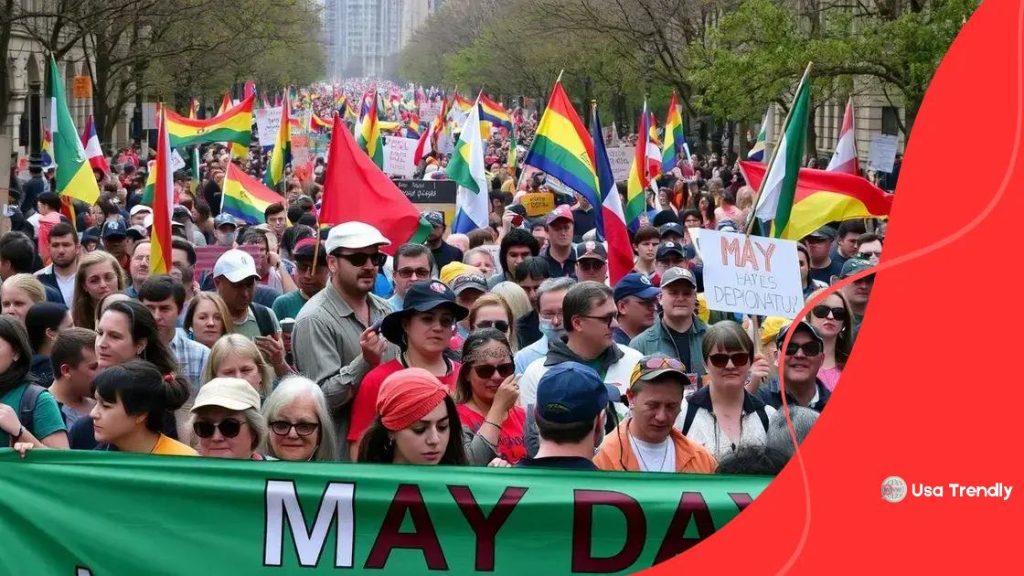May Day demonstrations spread nationwide: What you need to know

May Day demonstrations spread nationwide, serving as a powerful platform for advocating workers’ rights, social justice, and community solidarity while leveraging social media for mobilization and awareness.
May Day demonstrations spread nationwide, uniting people around critical social and economic issues. Have you thought about what drives this growing movement and its implications for our society?
Historical context of May Day demonstrations
Understanding the historical context of May Day demonstrations is essential to grasping their significance today. These events have roots that trace back to the labor movement in the late 19th century, where workers pushed for better conditions and rights. May Day has become a symbol of this struggle, celebrated as International Workers’ Day in many countries.
Key Historical Events
Historically, May Day is linked to the Haymarket affair of 1886 in Chicago, which was a pivotal moment in labor history. This protest aimed for an eight-hour workday, leading to tragic consequences but igniting a global labor movement. Today, we see remnants of this history in the protests held on May 1st each year, emphasizing workers’ rights and social justice.
- Recognition of labor rights in various nations.
- Impact of the Haymarket affair on labor laws.
- Evolution of May Day celebrations worldwide.
The context of May Day also varies by region. In some places, it represents political activism, while in others, it is a day for general workers’ rights and unity. Whether it’s celebrating past victories or fighting ongoing struggles, the events of May Day serve as a powerful reminder of the collective power of workers.
Global Observance
Different countries observe this day with unique traditions. For instance, in the United States, it often involves marches and rallies focusing on various social issues, sometimes overshadowed by the celebration of Labor Day in September. Conversely, places like Europe celebrate with a festive atmosphere, highlighting solidarity among workers and acknowledging historical struggles.
The widespread nature of these demonstrations today reflects an enduring legacy, demonstrating the global solidarity and continued fight for workers’ rights. Understanding the historical context is crucial to appreciating how these events mobilize people and amplify their voices against injustice.
Key themes and messages in recent protests
Recent protests, particularly during May Day demonstrations, highlight several key themes and powerful messages. Activists from various backgrounds come together to address pressing social issues, reflecting the voices of the marginalized and advocating for change. Through their unity, they emphasize the importance of collective action in challenging systemic injustices.
Solidarity and Worker Rights
One major theme is the solidarity among workers, regardless of their industry or background. This collective spirit strengthens their demands for fair wages, safe working conditions, and benefits. Many participants carry signs advocating for the rights of essential workers, who have faced unprecedented challenges during recent global events. The shared goal is clear: improving conditions for all and achieving a just labor market.
- Emphasis on fair wages and benefits.
- Focus on safe working environments.
- Recognition of essential workers’ contributions.
Another important aspect of recent protests is the demand for social justice. Demonstrators often link labor rights with broader issues such as racial equality, women’s rights, and climate action. In this way, they highlight how these struggles intersect and how addressing them together will lead to a more equitable society. This intersectional approach promotes a sense of belonging and encourages more individuals to participate.
Environmental Concerns
Additionally, environmental concerns have taken center stage in many May Day demonstrations. Protesters advocate for sustainable practices and environmental justice, stressing that workers’ rights and a healthy planet are interconnected. By pushing for policies that protect both labor and the environment, demonstrators underscore the need for a holistic approach to activism.
Another vital message evident in these protests is the importance of political engagement. Many activists call for changes in legislation to support workers’ rights and environmental regulations. They urge participants to vote and hold their local and national leaders accountable, ensuring that the voices of the working class are heard in policy-making. This active involvement aims to create long-lasting change that extends beyond just one day of demonstrations.
The role of social media in mobilization

The role of social media in mobilization has become increasingly vital in recent years, especially during significant events like the May Day demonstrations. Platforms such as Twitter, Facebook, and Instagram enable activists to spread their messages quickly and effectively, reaching a global audience in real-time.
Instant Communication
One of the primary benefits of social media is the ability to communicate instantly. Activists can share updates, organize events, and coordinate efforts almost immediately. This immediate response helps in rallying support quickly and effectively, allowing movements to gain momentum.
- Creation of event pages to gather participants.
- Live updates during demonstrations.
- Encouragement of interactive discussions among supporters.
Moreover, social media aids in storytelling and sharing personal experiences. This is especially important for marginalized voices, who can share their narratives and connect with others facing similar struggles. By highlighting personal accounts, the movement gains emotional weight, allowing others to empathize and engage.
Visual Impact and Viral Reach
The visual nature of social media enhances the impact of protests. Powerful images and videos from events can go viral, drawing more attention to the cause. When a striking image of a protest is shared widely, it can spark discussions and encourage people to join or support the movement.
Additionally, hashtags play a crucial role in creating awareness. By using specific hashtags, activists can trend their messages across different platforms. Hashtags like #MayDay or #WorkersRights allow users to find related content easily, fostering a sense of community and shared purpose.
Despite its many advantages, the reliance on social media also poses challenges. Misinformation can spread just as quickly as accurate information. Therefore, it is essential for activists to fact-check and remain vigilant against false narratives. Managing the flow of information is critical to maintaining credibility and trust within the movement.
Impact of demonstrations on local communities
The impact of demonstrations on local communities is significant and multifaceted. Protests, especially those held on May Day, often bring issues to the forefront that affect the everyday lives of residents. These events can create both positive and negative consequences for communities that host them.
Community Awareness and Engagement
One positive impact is increased community awareness. Demonstrations spotlight critical issues like labor rights, social justice, and environmental concerns, encouraging residents to discuss and engage with these topics. When people see their neighbors participating in protests, they often feel inspired to learn more and contribute their voices.
- Increased discussions on social issues.
- Greater awareness of local and global challenges.
- Encouragement to participate in civic activities.
Additionally, protests can foster a sense of solidarity among community members. When residents gather to support a cause, they build connections that strengthen community ties. These relationships can lead to collaborative efforts that extend beyond the protest itself, such as community organizing and localized campaigns for change.
Challenges and Disruptions
However, demonstrations can also bring challenges. Local businesses may experience disruptions due to road closures and increased foot traffic. While some businesses might benefit from the influx of visitors, others could struggle with accessibility issues. It’s essential for local governments and organizers to coordinate efforts to minimize negative impacts.
Moreover, the presence of law enforcement during protests can lead to tension, affecting the overall atmosphere in the community. Residents might feel uneasy or concerned about potential conflicts. Balancing safety with the right to protest is crucial for maintaining community trust and support.
Ultimately, the impact of demonstrations on local communities is complex. While they can raise awareness and foster a sense of unity, they may also introduce challenges that need to be addressed through collaboration and open dialogue among community members.
Future outlook for May Day activism
The future outlook for May Day activism is shaped by ongoing social movements and changing dynamics in labor rights. As we move forward, it is clear that this day will continue to hold significant meaning for activists advocating for workers’ rights and social justice.
Increased Global Participation
One promising aspect of May Day is the potential for increased global participation. With the rise of social media, activists around the world can connect and share ideas, leading to more coordinated actions across borders. This interconnectedness may strengthen the overall impact of demonstrations as a united voice emerges.
- Collaboration among international labor organizations.
- Unified campaigns addressing global issues.
- Empowerment of voices from various regions.
Another crucial factor is the growing awareness of intersectional issues. Activism is increasingly recognizing how various social justice movements intersect. Future May Day demonstrations may blend labor rights with environmental justice, racial equality, and gender rights. This holistic approach can attract diverse groups of people, enhancing solidarity.
Adapting to New Challenges
However, challenges remain. As political landscapes shift, activists must adapt their strategies. In some regions, governments may impose stricter regulations on protests. To counteract this, movements may seek to find innovative ways to mobilize support and maintain visibility.
Moreover, economic changes, especially post-pandemic, will impact worker rights. May Day activists need to address emerging issues such as gig economy protections and expanding health benefits for all workers. By focusing on relevant issues, they can ensure that the movement remains vibrant and impactful.
Finally, as younger generations become more involved, the messaging and tactics of May Day protests will likely evolve. New activists bring fresh perspectives and ideas, leading to dynamic protests that resonate with a diverse audience. This adaptability will be key in keeping the spirit of May Day alive and ensuring that it continues to inspire advocacy for workers’ rights.
FAQ – Frequently Asked Questions About May Day Activism
What is the significance of May Day demonstrations?
May Day demonstrations symbolize the labor movement and advocate for workers’ rights, social justice, and equity.
How has social media impacted recent May Day protests?
Social media has amplified voices, organized events quickly, and connected activists globally, making demonstrations more impactful.
What challenges do May Day activists face today?
Activists encounter challenges such as government restrictions on protests, misinformation, and the need to address emerging labor issues.
How can individuals support May Day activism?
Individuals can support by participating in protests, educating themselves on social justice issues, and sharing information on social media.
SEE MORE CONTENT